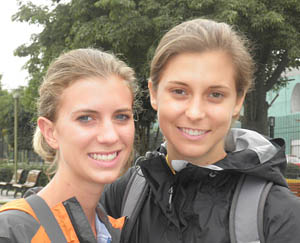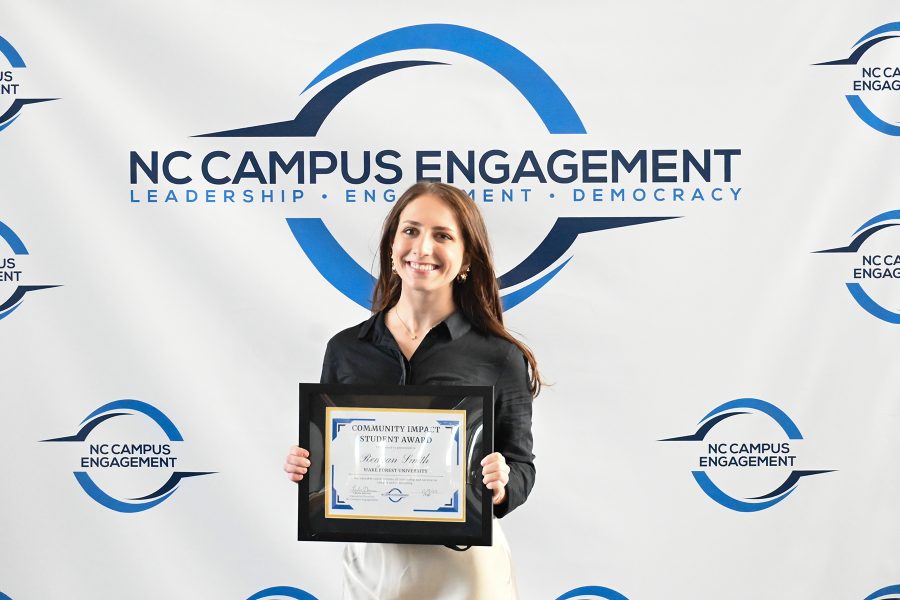Brazil nut harvesting
Brazil nut harvesting provides more than half the yearly income for thousands of families in the Amazon. Two Wake Forest seniors, Cate Berenato and Katherine Sinacore, spent four weeks in Peru this summer working with the Amazon Conservation Association (ACA) to determine which programs are best at helping sustain Brazil nut harvesters, their families and the rainforest.
Results from Berenato’s and Sinacore’s research have far-reaching implications for managing forested areas at risk of being destroyed by logging, mining and land clearing.

Seniors Cate Berenato and Katherine Sinacore conducted research in Peru to help sustain Brazil nut harvesters and the rainforest.
The ACA provides harvesters with information on how to care for trees and increase yield. The more income generated by Brazil nut harvesting, the more likely the trees will remain standing.
Berenato and Sinacore set out to help the ACA determine which projects produce the best results.
“It’s one thing to read about the Amazon and conserving rainforests but another to understand the impact first-hand,” says Berenato, an English major and environmental studies minor. “Sustainable efforts have to strike a balance between the natural world and human relations. If the rainforest disappears that’s bad for the environment, but people also rely on these trees to feed their families. Good programs need to offer win-win solutions.”
Berenato studied the sociological aspects of the programs to find out if Brazil nut harvesters and their families are receiving helpful information through appropriate channels.
“The ACA publishes booklets meant to provide general information about the Brazil nut, tips on respecting the environment and methods for improving harvesting techniques,” says Berenato. “My research indicates that the vast majority of Brazil nut harvesters read these publications. I also found that harvesters listen to radio programs that provide similar information, while also providing details on the state of the Brazil nut market. Both harvesters that fall under the ACA and the non-ACA harvesters use these materials, so preliminary results show the ACA should continue to spend money producing them.”
Sinacore, a biology major, focused on assessing the impact of harvesting methods.
Her data on juvenile trees will help determine how Brazil nut trees are regenerating in the different areas.
“My research compares the percentage of juvenile trees in areas where harvesters are receiving training and information under ACA direction with the percentage of juvenile trees in areas where harvesters are working independently,” she says. “A higher percentage of juvenile trees in a given area indicate the forest is rejuvenating more quickly, and it’s a way to gauge whether ACA-sponsored programs are making a difference.”
Data collection is continuing under the Ministry of Environment in Peru.
Associate Professor of Biology Miles Silman, who is mentoring the students with their projects, describes the backbreaking work of harvesting Brazil nuts. The Brazil nut tree, one of the largest trees in the Amazon at 100 to 150 feet, drops its fruit during a five- to six-month rainy season. Each fruit, which resembles a coconut, contains about 10 to 20 seeds or “nuts.” The harvesters break open the pods and carry the nuts in sacks on their backs to drying facilities outside of the forest.
“Harvesters know every tree on their land, visiting them every year and carrying the nuts to market,” he says. “The state is working to support and promote this activity as an income-generating business by giving Brazil nut harvesters titles, or land concessions, to harvest certain areas of the forest.”
Some harvesters who work these concessions agree to use the land for Brazil nut harvesting only, and they receive assistance from non-government organizations, such as the ACA. The data Berenato and Sinacore gathered compares ACA-assisted concessions with non-ACA-assisted concessions to help determine what incentives and programs work.
Though research and scientific study were the focus of the trip, both students agree that one of the best parts of their work, which was funded through the Richter Scholarship program, was developing relationships with the locals. “We interviewed families and traveled out to concessions to talk with harvesters,” says Sinacore. “It was a phenomenal opportunity.”
Caitlin Crawford, an ACCIAC scholarship award recipient, was also a member of the team of student researchers. A senior majoring in accounting and minoring in Spanish, Crawford worked with Berenato and Sinacore conducting and translating interviews used for sociological investigations. She also translated research and ACA booklets and correspondence providing Berenato with data for her biological research and Sinacore with information that helped in developing interview questions.
Categories: Environment & Sustainability, Experiential Learning, Global Wake Forest, Mentorship, University Announcements
Media Contact
Wake Forest News
media@wfu.edu
336.758.5237



